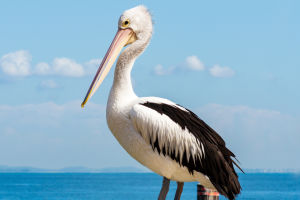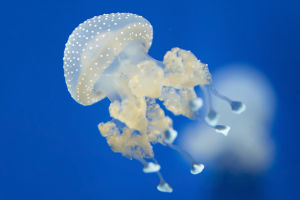Jellyfish, mysterious and graceful marine creatures, have a history of more than 500 million years.
They are one of the oldest multicellular organisms on Earth.
Although their bodies may seem simple, jellyfish play an important role in the marine ecosystem.
There are many species of jellyfish, ranging from the giant lion's mane jellyfish to the tiny freshwater jellyfish, each of which shows the wonder and complexity of nature.
Jellyfish have a very special body structure. They have no bones, heart, or brain. The body of a jellyfish is mainly composed of water, accounting for about 95% to 98% of its body weight.
They hunt by relying on special cells called "stinging cells", which contain toxins to paralyze their prey. Jellyfish usually feed on plankton, small fish, and other tiny marine creatures.
Once the prey comes into contact with the tentacles of the jellyfish, the stinging cells will immediately release toxins, which will incapacitate the prey and then be slowly swallowed by the jellyfish.
Although jellyfish may seem simple, their lifestyle is very complex. The life of a jellyfish can be divided into two stages: the polyp stage and the medusa stage. The polyp stage is usually fixed to the seafloor and resembles seaweed in form. It reproduces alone to produce young jellyfish.
The medusa stage is the jellyfish we usually see. It floats freely in the sea and reproduces. This biphasic life history makes the jellyfish life cycle have both fixed and free-floating parts, which provides great flexibility for their survival.
Jellyfish are both beautiful and dangerous. Many species of jellyfish have toxins, especially the square jellyfish, which are one of the most deadly creatures on the earth. The tentacles of the square jellyfish contain potent toxins that can kill within minutes.
Despite this, most jellyfish toxins are not fatal to humans, but being stung by a jellyfish can still cause intense pain and allergic reactions. Therefore, people swimming on the beach are often warned to be aware of the presence of jellyfish and avoid unnecessary contact.
Although jellyfish are poisonous, they are regarded as delicacies in some cultures, especially in Asia. Jellyfish are used to make dishes such as salads or sushi. The gelatinous body of jellyfish is rich in protein and low in fat and calories, making it a healthy ingredient.
In addition, the mucus and other components of jellyfish are also used in medical research and are expected to play a role in wound healing and anti-inflammatory effects.
The application of jellyfish in the biomedical field is gradually expanding. Scientists hope to reveal the bioactive substances in jellyfish through in-depth research to develop new drugs and treatments.
Jellyfish not only occupy an important position in the ecosystem, but their existence also provides important clues for scientific research. For example, by studying luminous jellyfish, scientists discovered a substance called green fluorescent protein (GFP), which can emit light in organisms.
Today, GFP has been widely used in biomedical research to track protein movement in cells or mark specific genes. This discovery even laid the foundation for the awarding of the 2008 Nobel Prize in Chemistry, highlighting the great contribution of jellyfish in the field of science.
In recent years, with the intensification of problems such as climate change and overfishing, the surge in the number of jellyfish has become a major problem in the global marine ecosystem.
Due to human overfishing of fish, many jellyfish have fewer natural enemies, allowing jellyfish to reproduce rapidly. In addition, rising ocean temperatures also provide a more suitable environment for the growth of jellyfish.
In some areas, the explosive reproduction of jellyfish has even led to a "jellyfish invasion", where their large gatherings have clogged fishing nets, damaged the cooling systems of coastal nuclear power plants, and even affected the development of tourism.
However, the increase in the number of jellyfish is not entirely a bad thing. They act as important regulators in the marine ecosystem. For example, when the number of fish decreases, jellyfish can fill the gap and maintain the balance of the aquatic food chain.
In addition, jellyfish provide shelter and habitat for many aquatic organisms. Some small fish even swim between the tentacles of jellyfish, using the toxicity of jellyfish to protect themselves from predators.
As one of the oldest life forms on Earth, jellyfish demonstrate the complexity and wonder of nature. Their existence is not only an indispensable part of the marine ecosystem but also provides scientists with endless research inspiration.
Although they occasionally bring inconvenience to human life, we should recognize the importance of jellyfish in ecological balance and coexist harmoniously with them through effective management measures.


